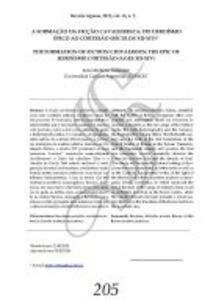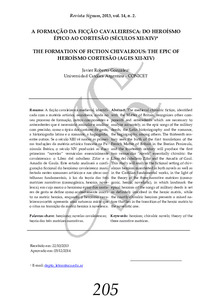Please use this identifier to cite or link to this item:
https://repositorio.uca.edu.ar/handle/123456789/5201| Título: | A formação da ficção cavaleiresca : do heroísmo épico ao cortesão (séculos XII-XIV) | Autor: | González, Javier Roberto | Palabras clave: | LITERATURA MEDIEVAL; LIBROS DE CABALLERIA; ROMANCERO; HEROISMO | Fecha de publicación: | 2013 | Editorial: | Associação Brasileira de Estudos Medievais, Universidad Federal de Minas Gerais | Cita: | González, Javier R. “Aformação da ficção cavaleiresca : do heroísmo épico ao cortesão (séculos XII-XIV) ” [en línea]. Signum, 14 (2), 2013. Disponible en: https://repositorio.uca.edu.ar/handle/123456789/5201 | Resumen: | Resumo: A ficção cavaleiresca medieval, identifi-cada com a matéria artúrica, reconhece, ainda no seu processo de formação, outros componentes e antecedentes que é necessário assinalar e analisar com precisão, como a épica dos cantares de gesta, a historiografia latina e o romance, a hagiografia, entre outros. Se o século XIII vê nascer as primei-ras traduções da matéria artúrica francesa na Pe-nínsula Ibérica, o século XIV produzirá as duas primeiras “novelas” vernáculas essencialmente cavaleirescas: o Libro del caballero Zifar e o Amadis de Gaula. Este estudo analisará a confi-guração ficcional do heroísmo cavaleiresco mani-festada nestes romances artúricos e nas obras cas-telhanas fundamentais, à luz da teoria das três matrizes narrativas (cosmogônica, heroica, nove-lesca), em cujo marco o heroísmo épico dos canta-res de gesta se define como acabadamente inscri-to na matriz heroica, enquanto o heroísmo cava-leiresco-cortês apresenta uma natureza mista que o situa na transição da matriz heroica à novelesca. Abstract: The medieval chivalric fiction, identified with the Matter of Britain, recognizes other com-ponents and antecedents which are necessary to analyze accurately, as the epic songs of the military deeds, the Latin historiography and the romance, the hagiography, among others. The thirteenth cen-tury sees the birth of the first translations of the French Matter of Britain in the Iberian Peninsula, and the fourteenth century will produce the first two vernacular "novels" essentially chivalric: the Libro del caballero Zifar and the Amadis of Gaul. This study will analyze the fictional setting of chiv-alrous heroism manifested in both novels as well as in the Castilian fundamental works, in the light of the theory of the three narrative matrices (cosmo-gonic, heroic, novelistic), in which landmark the epical heroism of the songs of military deeds is set as definitely inscribed in the heroic matrix, while the courtly-chivalric heroism presents a mixed na-ture that lies in the transition of the heroic matrix to the novelistic one. |
URI: | https://repositorio.uca.edu.ar/handle/123456789/5201 | ISSN: | 2177-7306 | Disciplina: | LITERATURA | Derechos: | Acceso Abierto | Fuente: | Signum, Vol. 14 Nº 2, 2013 |
| Appears in Collections: | Artículos |
Files in This Item:
| File | Description | Size | Format | |
|---|---|---|---|---|
| formacao-ficcao-cavaleiresca.jpg | 5,82 kB | JPEG |  View/Open | |
| formacao-ficcao-cavaleiresca.pdf | 394,93 kB | Adobe PDF |  View/Open |
Page view(s)
81
checked on Apr 30, 2024
Download(s)
133
checked on Apr 30, 2024
Google ScholarTM
Check
This item is licensed under a Creative Commons License

